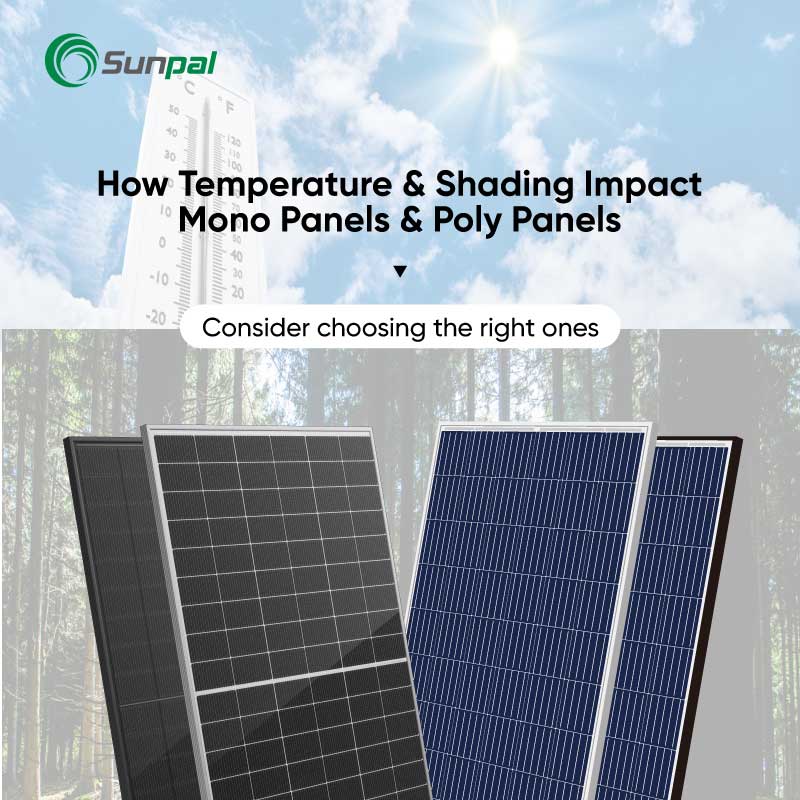
Ever stopped to wonder how temperature and shading affect the performance of your solar panels? It might seem like a minor detail, but in reality, understanding these environmental factors is pivotal for optimizing solar panel performance. As a high efficiency solar modules manufacturer like SUNPAL, our mission is to take these complex concepts and make them easier to understand. So, let's dive in and solve this renewable energy mystery together!
Understanding Mono and Poly Panels
Before we start analyzing the effects of temperature and shading, it's crucial to first understand the difference between monocrystalline (mono) and polycrystalline (poly) solar panels.
Mono panels are made of single-crystal silicon. Imagine them as the 'purebred' of solar panels. Their composition allows them to convert more sunlight into electricity, making them more efficient but also more expensive.
On the other hand, poly panels are made of multiple silicon fragments melted together. These 'mutts' of solar panels are less efficient due to their fragmented silicon structure. However, their lower efficiency comes with a more affordable price tag, making them a popular choice for many homeowners.
Have you ever stopped to ponder how our everyday weather plays a significant role in solar energy production? Well, grab a cozy spot, for we're about to share some insights that might just help you soak up the sun in the best way possible!
Turning up the Heat: How Temperature Affects Mono Panels
Temperature is a crucial player when it comes to the efficiency of Monocrystalline (or simply Mono) solar panels. Here's an intriguing fact - the performance of mono panels can vary depending upon the temperature around them.
Let's introduce a technical term at this point - 'Temperature Coefficient.' Now, don't let that intimidate you. It's a straightforward concept that indicates how much the efficiency of a panel decreases for every degree above 25°C (that's the optimal temperature, folks!).
Long story short, the blistering summer heat can put a slight damper on your Mono solar panels, mainly due to their high-temperature coefficients. So, for those living under the scorching sun, considering the temperature coefficient while choosing solar panels might be a good idea.
Weathering the Heat: Temperature and its Effect on Poly Panels
Just like their Mono siblings, Polycrystalline (Poly) solar panels see a shift in performance with temperature. Interestingly, Poly panels usually have a higher temperature coefficient compared to Mono panels. Does that mean they are superman against the sun’s heat? Well, not exactly! They're a bit more resilient in higher temperatures, but extreme weather can still affect their efficiency.
Playing Hide and Seek with the Sun: Shading and its Impact on Mono Panels
Shading - a seemingly harmless phenomenon that can disrupt the output of your Mono solar panels. Here's where 'Bypass Diodes' swing into action. These components, tiny but mighty, help minimize shading losses by letting the current bypass shaded cells.
The placement of the solar panels also spells a difference when it comes to mitigating shading. Factors like the direction of the panels, potential shading from nearby structures, and the sun's angle throughout the day should be factored in for optimal performance.
Out of the Shadow: The Influence of Shading on Poly Panels
Poly panels, too, are subject to the whims of shading. Once more, bypass diodes come to the rescue, ensuring minimal shading loss. As with Mono panels, strategizing on the placement of Poly panels can help optimize solar energy capture.
Mono Vs Poly: A Comparative Examination in Varying Climates
When you stack Mono and Poly panels against each other in different climate conditions, some exciting patterns emerge. Mono panels usually boast higher efficiency but lower temperature tolerance compared to Poly panels. Remember though, there isn't a one-size-fits-all solution! The type of panel that suits you most largely depends on your specific local environment and requires careful consideration.
The Winning Strategy: Optimizing Solar Panel Performance
Want to get the maximum bang for your buck from your solar panels? A well-devised strategy is key. Regular maintenance and cleaning are critical for both Mono and Poly panels. Did you know that seemingly insignificant dust and bird droppings can impact your panel's efficiency?
Setting up solar panels also needs some thought. Think of it like setting up a satellite dish - the better the positioning and direction, the better the reception!
Here Comes the Future: Upcoming Developments and Innovations
The solar industry is a hotbed of constant evolution, with continual research and advancements in panel technology. Down the line, we can look forward to improvements in temperature and shading tolerance for both Mono and Poly panels, thereby allowing us to harness solar energy even more effectively!
In summary, temperature and shading significantly impact the performance of both mono and poly panels. By understanding these factors and making informed decisions based on your specific environmental situations, you can optimize your solar panel performance.
Remember, becoming a solar energy user isn't just about installing some panels on your roof. It's about understanding how they work and how to make the most of them. After all, an informed consumer is a smart consumer!